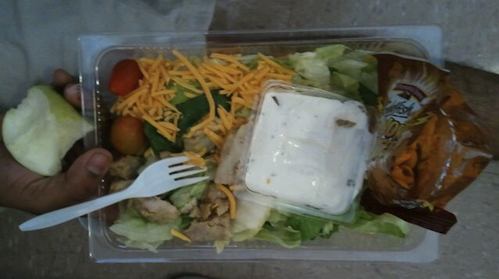
24 Oct A School Lunch I’d Gladly Eat
Commentary, Sean Shavers | Video, Ann Bassette
When I was in high school in Oakland, I never really questioned the cafeteria menu, I just knew that I wasn’t eating it because it didn’t look appealing and I had other options. For years school lunch was considered nasty and inedible by me and my peers. Many of us would grab a bag of chips from the vending machine and skip the lunch line entirely.
It wasn’t until recently, that I saw school lunch in a different way. Along with members of the Richmond Food Policy Council, I took a trip to Pittsburg High School to see the school’s nutritional program.
We we’re given a tour around the campus by Matt Belasco, the director of child nutrition services for Pittsburg Unified School District. He explained how and why the school had been remodeled, with child nutrition as part of the design. In fact, six out of 13 schools in Pittsburg were remodeled with a garden facility on campus, including Pittsburg High. Belasco said that child nutrition is his main objective now at the high school.
If kids don’t have a healthy meal before school it will affect how they learn, perform and behave in the classroom, Belasco said, so it’s essential that kids eat well, in order to think well. Belasco also mentioned that before the school was remodeled, they served about 800 meals a day. Now that number has shot up to 3,000.
As part of the initiative they also did away with off-campus lunch. A move that Belasco said was meant to discourage students from eating at corner stores and then not returning to school.
“We developed a system to counter act that,” Belasco said of the unhealthy lunches often eaten by students. “By providing clean drinking water, access to fruits and vegetables and a desirable school menu, we’ve done that.”
On the tour, we were escorted to the campus garden first, where a majority of the school’s produce is grown. Belasco said that the special-ed students were responsible for growing and maintaining the garden. There were fat, juicy looking eggplants, dark green cucumbers and bright colored peppers and tomatoes dotting the flourishing garden. The tomatoes are used for salsa and sauces, according to Belasco. The cucumbers could be used to make fruit infused “spa water.”
Last summer, members of the summer child nutrition program, along with students, grew and pulled up, sixty pounds of vegetables for the summer school lunch program. Their work saved the school money and gave students skills.
After the garden we went to the food carts. These carts were loaded with healthy snack items, like grapes, pears and carrots. These carts were basically small stations, for students on the go, who don’t want to wait in lunch lines. It seemed like a smart strategy to keep the cafeteria from over crowding.
To wrap up the day, we entered the cafeteria—the place where it all goes down. The first thing that struck me was the vending machines. They weren’t stocked with the usual fare: Candy, soda and chips. In place of the unhealthy items were bottle water and 100 percent juice containers.
On each end of the cafeteria were well organized salad bars. Each of them with a color coded system, to show students which food item belongs to which food group: Green for veggies, red for fruits, blue for milk, orange for grains and purple for protein. The system ensures students get their nutritional needs met, even without going through the lunch line.
Aside from the salad bars, there were four lunch stations throughout the cafeteria. At each station students are given food options. One station was the red, white, and blue deli. It served traditional American food, hot dogs, hamburgers and the like. There was a south of the border station, which served Latin cuisine, like tacos and burritos. Another one served Italian cuisine—think pastas, soup and bread. And finally, there was a hot wok express, which served Asian cuisine—rice, noodles and steamed veggies.
All of the variety makes it nearly impossible for students to complain about the menu
After walking around the campus and seeing all of the fresh meals, it was finally time to try the food. I decided to head south of the border.
The two tacos I had with cheese, salsa and sour cream were the bomb. The flavor, the crunch of the taco, the spicy salsa and the melted cheese were just right. It was far better than any school lunch I had ever eaten.
If I had access to all this goodness while I was in school, I would have definitely taken advantage of the free lunch program.






No Comments